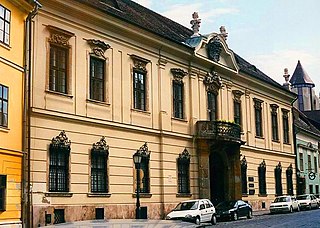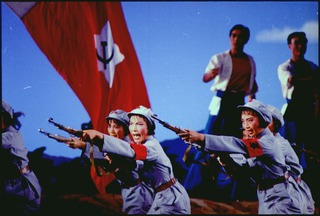| Hungarian National Ballet | |
|---|---|
| General information | |
| Name | Hungarian National Ballet |
| Local name | Magyar Nemzeti Balett |
| Year founded | 1884 |
| Principal venue | Hungarian State Opera House |
| Website | |
| Artistic staff | |
| Artistic Director | Tamás Solymosi |
| Other | |
| Formation | Principals First soloists Soloists Grand sujets Semi-soloists Corps de Ballet |
The Hungarian National Ballet (Hungarian : Magyar Nemzeti Balett) is a classical ballet dance company based in Budapest, Hungary. The ballet company is attached to the Hungarian State Opera House, which is also home to the Hungarian State Opera company and the Hungarian State Opera Orchestra. The ballet company was established in 1884.
Ballet performances began in Hungary during the 18th century, when they were held in private theatres at aristocratic castles. Professional companies were established that performed throughout Hungary and also toured abroad. The Budapest National Theatre increasingly serving a role as a home for the dancers. [1] The first ballet master of the National Theatre and Royal Opera was the Italian-Viennese Frederico Campilli (German: Friedrich Campilli, Hungarian: Campilli Frigyes), who worked in Budapest for 40 years. [2]
In 1884, the Hungarian Royal Opera House was opened (now known as the Hungarian State Opera House). The Hungarian National Ballet was part of the new theatre community. From the beginning, the Hungarian National Ballet had a reputation as one of the leading companies in Europe, although in the 19th century, the company had a very different structure:
The corps de ballet included 60 artists: 30 female dancers along with 30 regularly performing students. The company was led by two Italian and four Hungarian soloists. The opening Opera House had only female artists except for one single male dancer coming from Milan. [1]
Italian dance technique dominated the company in its early decades, [1] an aspect of the company's history that is shared with European companies such as the Czech National Theatre Ballet (Prague) during the same period. Staging was heavily influenced by Vienna. Consciousness of Hungarian national culture was soon brought to the stage, however, driven in large part by the work of Gyula Harangozó (1908-1974). Scene in a Country Tavern, performed in 1936, is considered a milestone of Hungarian ballet. Other characteristic works include Coppelia, Tricky Students, Sheherezade, and Promenade Music. [1] Hungarian folk dancing was fused with classical ballet into a new creation.
During the company's post-World War II period, László Seregi became the company choreographer. During this period, political and artistic developments resulted in a shift towards Russian technique. However, an element of Hungarian cultural influence remained. [1] During the 1970s, neoclassical ballet works from Western Europe and America were added to the company's repertoire. The Hungarian National Ballet staged works by George Balanchine, Maurice Béjart, Frederick Ashton, Hans van Manen, Alvin Ailey, Jiří Kylián and Robert North. Seregi’s choreographies, such as Spartacus, Romeo and Juliet, A Midsummer Night's Dream and The Taming of the Shrew, have been central to the reputation of Hungarian ballet both at home and abroad since the late 1960s. [1] Michael P. Price designed the lighting for the company's premiere American tour. [3]
Gyula Harangozó Jr. was artistic director from 1996 to 2005. Under his influence, the company performed a number of works by Hungarian choreographers: Lilla Pártay (full-length pieces, Anna Karenina, Wolfgang AMADEUS Mozart, Gone with the Wind and The Golden Brush); Gábor Keveházi (full-length piece, Zorba); and Attila Egerházi (contemporary ballet one-act pieces). Harangozó Jr. has been succeeded by Gábor Keveházi, a famous ballet dancer in his own right. Keveházi has maintained a balance of classical repertoire pieces such as Swan Lake and Giselle, and newer works. [1]
The Hungarian National Ballet has long been known as a company with a particularly strong repertoire of folk pieces reflecting national culture. [4] It also remains one of the world's leading classical companies with over 100 dancers. The Hungarian National Ballet also tours internationally.

Dame Ninette de Valois was an Irish-born British dancer, teacher, choreographer, and director of classical ballet. Most notably, she danced professionally with Serge Diaghilev's Ballets Russes, later establishing the Royal Ballet, one of the foremost ballet companies of the 20th century and one of the leading ballet companies in the world. She also established the Royal Ballet School and the touring company which became the Birmingham Royal Ballet. She is widely regarded as one of the most influential figures in the history of ballet and as the "godmother" of English and Irish ballet.

Romeo and Juliet, Op. 64, is a ballet by Sergei Prokofiev based on William Shakespeare's play Romeo and Juliet. First composed in 1935, it was substantially revised for its Soviet premiere in early 1940. Prokofiev made from the ballet three orchestral suites and a suite for solo piano.

The Royal Ballet is a British internationally renowned classical ballet company, based at the Royal Opera House in Covent Garden, London, England. The largest of the five major ballet companies in Great Britain, the Royal Ballet was founded in 1931 by Dame Ninette de Valois. It became the resident ballet company of the Royal Opera House in 1946, and has purpose-built facilities within these premises. It was granted a royal charter in 1956, becoming recognised as Britain's flagship ballet company.

Budapest has long been an important part of the music of Hungary. Its music history has included the composers Franz Liszt, Ernő Dohnányi, Zoltán Kodály and Béla Bartók and the opera composer Ferenc Erkel.

Queensland Ballet, founded in 1960 by Charles Lisner OBE, is the premier ballet company of Queensland, Australia and is based in Brisbane. It is one of only three full-time, professional classical ballet companies in Australia. The Company has had 5 previous Artistic Directors, and is currently led by Chinese-born ballet star Li Cunxin AO.

Character dance is a specific subdivision of classical dance. It is the stylized representation of a traditional folk or national dance, mostly from European countries, and uses movements and music which have been adapted for the theater.

The Maria Bieșu National Opera and Ballet Theatre in Chişinău, Moldova, is one of the leading opera and ballet theatres in Eastern Europe. It is housed in a building on the Boulevard Stefan the Great, one of the main roads in Chişinău. In 2012, it was given the name of the renowned opera singer Maria Bieșu.

Ballet is a formalized dance form with its origins in the Italian Renaissance courts of 15th and 16th centuries. Ballet spread from Italy to France with the help of Catherine de' Medici, where ballet developed even further under her aristocratic influence. An early example of Catherine's development of ballet is through 'Le Paradis d' Amour', a piece of work presented at the wedding of her daughter Marguerite de Valois to Henry of Navarre. Aristocratic money was responsible for the initial stages of development in 'court ballet', as it was royal money that dictated the ideas, literature and music used in ballets that were created to primarily entertain the aristocrats of the time. The first formal 'court ballet' ever recognized was staged in 1573, 'Ballet des Polonais'. In true form of royal entertainment, 'Ballet des Polonais' was commissioned by Catherine de' Medici to honor the Polish ambassadors who were visiting Paris upon the accession of Henry of Anjou to the throne of Poland. In 1581, Catherine de' Medici commissioned another court ballet, Ballet Comique de la Reine, however it was her compatriot, Balthasar de Beaujoyeulx, who organized the ballet. Catherine de' Medici and Balthasar de Beaujoyeulx were responsible for presenting the first court ballet ever to apply the principles of Baif's Academie, by integrating poetry, dance, music and set design to convey a unified dramatic storyline. Moreover, the early organization and development of 'court ballet' was funded by, influenced by and produced by the aristocrats of the time, fulfilling both their personal entertainment and political propaganda needs.
The La Scala Theatre Ballet is the resident classical ballet company at La Scala in Milan, Italy. One of the oldest and most renowned ballet companies in the world, the company pre-dates the theatre, but was officially founded at the inauguration of La Scala in 1778. Many leading dancers have performed with the company, including Mara Galeazzi, Alessandra Ferri, Viviana Durante, Roberto Bolle and Carla Fracci. The official associate school of the company is the La Scala Theatre Ballet School, a constituent of the La Scala Theatre Academy.
The Hamburg Ballet is a ballet company based in Hamburg, Germany. Since 1973, it has been directed by the American dancer and choreographer John Neumeier. In addition there is a ballet school, School of the Hamburg Ballet, established in 1978. The performances of the Hamburg Ballet are usually held at the Hamburg State Opera, while the training and education facility is the "Ballettzentrum Hamburg – John Neumeier".

The National Ballet of China (NBC), known in China as the Central Ballet Troupe was founded on 31 December 1959. It is the national ballet company of the People's Republic of China.

Olga Esina is a Russian ballerina who was educated at the Vaganova Academy of Russian Ballet in Saint Petersburg, Russia. In 2010 she became First Solo Dancer at the Vienna State Ballet.
National Ballet of Ukraine from the Taras Shevchenko National Opera of Ukraine performs works of classical ballet and tours internationally. It currently has 24 ballets in its repertory, one of the largest in the world, and has had many notable dancers among its members.
The Tokyo Ballet is a classical ballet company, based in Tokyo, Japan, founded in 1964.
The National Theatre Ballet in Prague, Czech Republic was founded in 1883. It is based in Prague's National Theatre, which is also home to a drama company and an opera company. The company has a long history of performing Czech works in addition to international classics. In recent decades, more Western works have also been added to the repertoire.

László Seregi was a Hungarian dancer and choreographer who served as the primary choreographer of the National Opera of Budapest.
Pál Frenák is a Hungarian dancer, director and choreographer. His aesthetic is influenced by sign language, architecture, cinema, Butoh, and by the work of French philosopher, Gilles Deleuze. His company was founded at the height of European Post-Dramatic Theater, and came to the fore during Hungary’s transition from communism.
Attila Egerházi born is a Hungarian former dancer and contemporary dance choreographer

Krzysztof Pastor is a Polish dancer, choreographer and ballet director. He was resident choreographer with the Dutch National Ballet in Amsterdam from 2003 to 2017, director of the Polish National Ballet in Teatr Wielki – Polish National Opera in Warsaw since 2009 and at the same time from 2011 until 2020 was the artistic director of the ballet of the Lithuanian National Opera and Ballet Theatre in Vilnius.
Eugene Ballet is an American ballet company based in Eugene, Oregon. A resident company of the Hult Center for the Performing Arts, it performs a repertoire of full-length classical ballets, contemporary pieces, and operates a ballet academy. For more than 20 years, the National Endowment for the Arts has funded Eugene Ballet performances throughout the Pacific Northwest and nationally.